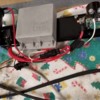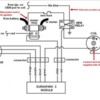Well, that's the way electrical engineers speak Rocky. It's kinda' like Einstein writing Shakespeare.
http://www.youtube.com/watch?v=BWi-ZgaSCEwTheir hearts are in the right place, they just don't get the nuances necessarily of the spoken language? Makes sense to them.
They impressed the other Ph.D.'s with their paper that's how they got theirs?
Here's a neat video showing the P-E ignition firing and self cleaning a fouled up spark plug.
For me, this is perfect with the Webers. No way will an MSD do this. Went through a lot of plugs with mine, when THEY were working. Then they would just stop, like you had to put another quarter in the change box?
In fact an MSD WILL NOT FIRE A FOULED PLUG! I just don't understand why anyone knowledgeable would use them, unless someone gave you their broken one? Plenty of those around for sure.
http://pantera-electronics.com...files/FouledPlug.MOVBasically what the above quote means is that only a points fired ignition needs a ballast resistor and that the P-E unit can not over heat or under fire the coil.
You put the hottest flame throwing e-coil in it and just stand back and make sure it doesn't think you are a spark plug? Man that hurts!

What exactly the MSD unit needs, besides dependability, everyone is still trying to figure out? It's really outdated '60s CD technology.
Additional ignition information: Just in case you got bored Rocky, munch on this?
Pantera-Electronics Inductive Engine Ignition Controller.
The most significant advantage of inductive ignition systems is that inductive coils are generally more efficient than capacitive discharge coils as they can provide longer spark duration that can ensure complete combustion. The ability to provide longer spark duration is because inductive coils only provide enough energy to cross the spark gap; the remaining energy from the ignition coil is used to maintain the spark.
Electronic capacitor discharge ignition (CDI) systems have been common on internal combustion engines because the technology has been in use since the 1960's. Capacitive discharge coils release almost all of their energy instantaneously, therefore considerably reducing the amount of energy available to maintain the spark.
Capacitive discharge ignition systems work by storing energy in an external capacitor, which is then discharged into the ignition coil primary winding when required. This rate of discharge is much higher than that found in inductive systems, and causes a corresponding increase in the rate of voltage rise in the secondary coil winding. This faster voltage rise in the secondary winding creates a spark that can allow combustion in an engine that has excess oil or an over rich fuel air mixture in the combustion chamber.
The high initial spark voltage avoids leakage across the spark plug insulator and electrodes caused by fouling, but leaves much less energy available for a sufficiently long spark duration; this may not be sufficient for complete combustion in high compression, turbo or supercharged engines. With inductive ignition systems more energy can be delivered to the secondary winding of the coil than in a capacitive ignition system. In fact, with the same power supply current, up to five times more energy can be delivered to the secondary winding of an inductive ignition coil than to a capacitive discharge coil.
Typically a capacitive discharge system will deliver a maximum of 10 millijoules of energy compared to an inductive ignition system delivering more like 50 millijoules of energy and potentially in excess of 100 millijoules. This large difference in supplied energies will mean an inductive system can provide spark duration of 2000 microseconds or more in a single spark, compared to 600 microseconds for a capacitive system.
Ignition in lean fuel mixtures by capacitor discharge systems can sometimes be accomplished by the use of multi-spark ignition, where the ignition system duplicates the prolonged spark of inductive spark systems by sparking a number of times during the cycle. The multi-spark ignition typically functions to a maximum of 3,000 RPM. This limitation is due to the time required to charge the capacitor.
The high energy and long spark durations are a considerable advantage since they provide better ignition of lean or non-homogenous air/fuel mixtures. In many cases engines that are unable to meet emission standards with capacitive discharge systems can be bought into compliance with electronic inductive ignition systems....and,
You still don't need a ballast resistor The Ford Duraspark is a VERY nice generic set up for a Pantera, I DEFINITELY AGREE but it is a generic set up. Problem is the Pantera is specific and has specific requirements. The P-E unit is the specific unit UPGRADE to the Duraspark THAT I NEEDED.
ANYONE RUNNING WEBERS IN A PANTERA NEEDS THE P-E IGNITION! You will see the difference.
Ignitions do not make horsepower for you. You want to minimize the amount of power that you loose from it's lack of efficiency. The anti-fouling, plug cleaning feature of this ignition is what you expected from the MSD but never got from it.
I'd still rather just say, try this, it works. Reading ALL this technical stuff just gives me a headache? Just like Sherman does.
I guess it's kinda' like the Niagara Falls routeen. Just don't say, Niagara Falls! You'll just start him up all over again!





